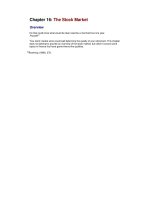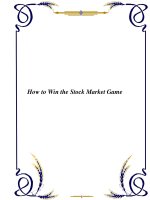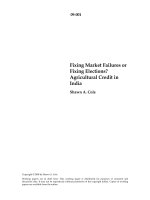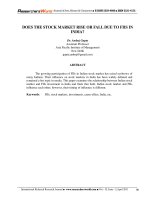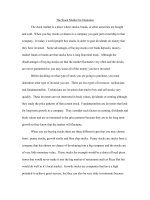DOES THE STOCK MARKET RISE OR FALL DUE TO FIIS IN INDIA
Bạn đang xem bản rút gọn của tài liệu. Xem và tải ngay bản đầy đủ của tài liệu tại đây (105.62 KB, 9 trang )
-Journal of Arts, Science & Commerce
■
E-ISSN 2229-4686 ■ ISSN 2231-4172
International Refereed Research Journal ■
w
w
w
w
w
w
.
.
r
r
e
e
s
s
e
e
a
a
r
r
c
c
h
h
e
e
r
r
s
s
w
w
o
o
r
r
l
l
d
d
.
.
c
c
o
o
m
m ■ Vol.– II, Issue –2,April 2011
99
DOES THE STOCK MARKET RISE OR FALL DUE TO FIIS IN
INDIA?
Dr. Ambuj Gupta
Assistant Professor
Asia Pacific Institute of Management
New Delhi
ABSTRACT
The growing participation of FIIs in Indian stock market has raised eyebrows of
many Indians. Their influence on stock markets in India has been widely debated and
remained a hot topic in media. This paper examines the relationship between Indian stock
market and FIIs investment in India and finds that both, Indian stock market and FIIs
influence each other; however, their timing of influence is different.
Keywords: FIIs, stock markets, investments, cause-effect, India, etc.
-Journal of Arts, Science & Commerce
■
E-ISSN 2229-4686 ■ ISSN 2231-4172
International Refereed Research Journal ■
w
w
w
w
w
w
.
.
r
r
e
e
s
s
e
e
a
a
r
r
c
c
h
h
e
e
r
r
s
s
w
w
o
o
r
r
l
l
d
d
.
.
c
c
o
o
m
m ■ Vol.– II, Issue –2,April 2011
100
INTRODUCTION:
Some of the market pundits believe that FIIs are responsible for rise or fall in the Indian stock
market. Consequently, we see the headlines like, ‘FIIs drive Sensex to 2-month high’ or ‘FII selling
drives down stock prices for 3rd day-Volatility may continue, say market players’ etc which use to
appear in business newspapers, most frequently. This raises a question as to whether FIIs are really a
cause or effect of the rise or fall in the Indian stock market.
One of the most important features of the development of stock market in India in the last 20
years has been the growing participation of FIIs. Since September, 1992 when FIIs were allowed to
invest in India, the no. of FIIs has grown over a period of time. At end-march 2009, there were 1626
FIIs registered with SEBI. (Table 1)
TABLE 1
FIIs REGISTERED WITH SEBI
YEAR FIIs AT END OF MARCH NET ADDITIONS IN FIIs
DURING THE YEAR
1993-94 3 3
1994-95 156 153
1995-96 353 197
1996-97 439 86
1997-98 496 57
1998-99 450 -46
1999-00 506 56
2000-01 527 21
2001-02 490 -37
2002-03 502 12
2003-04 540 38
2004-05 685 145
2005-06 882 197
2006-07 997 115
2007-08 1,319 322
2008-09 1,626 307
Source: SEBI
This is not unusual as most of the developing economies might be experiencing the same
patterns. The increasing role of FIIs has brought in the development of our stock markets as well such
as expansion of the business in securities, increased depth and breadth of the market, etc.
FIIs contribute to almost 13% of the entire market capitalization at National Stock Exchange
in India. If we talk of FIIs investment, this has been continuously grown over years except 1998-99
and 2008-09 when FIIs sold more than they purchased in Indian stock market. (Table 2)
-Journal of Arts, Science & Commerce
■
E-ISSN 2229-4686 ■ ISSN 2231-4172
International Refereed Research Journal ■
w
w
w
w
w
w
.
.
r
r
e
e
s
s
e
e
a
a
r
r
c
c
h
h
e
e
r
r
s
s
w
w
o
o
r
r
l
l
d
d
.
.
c
c
o
o
m
m ■ Vol.– II, Issue –2,April 2011
101
TABLE 2
FIIs INVESTMENTS IN INDIA
YEAR Gross
Purchase
(Rs.crore)
Gross Sales
(Rs.crore)
Net
Investment
(Rs.crore)
Net
Investment
(USD mn)
Cumulative
Net
Investment
((USD mn.)
1 2 3 4 5 6
1992-93 18 4 13 4 4
1993-94 5,593 467 5,127 1,634 1,638
1994-95 7,631 2,835 4,796 1,528 3,167
1995-96 9,694 2,752 6,942 2,036 5,202
1996-97 15,554 6,980 8,575 2,432 7,635
1997-98 18,695 12,737 5,958 1,650 9,285
1998-99 16.116 17,699 -1,584 -386 8,899
1999-00 56.857 46.735 10,122 2,474 11,373
2000-01 74,051 64,118 9,933 2,160 13,532
2001-02 50,071 41,308 8,763 1,839 15,372
2002-03 47,062 44,372 2,689 566 15,937
2003-04 1,44,855 99,091 45,764 10,005 25,943
2004-05 2,16,951 1,71,071 45,880 10,352 36,294
2005-06 3.46,976 3,05,509 41,467 9,363 45,657
2006-07 5,20,506 4,89,665 30,841 6,821 52,478
2007-08 9,448,018 8,81,839 66,179 16,442 68,919
2008-09 6.14,576 6,60,386 -45,811 -9,837 59,082
2009-10 8,46,438 7.03.780 1,42,658 30,253 89,335
Source: SEBI
The net cumulative investments by FIIs stood at USD 89.3 billion at the end of March, 2010.
Because of their war chests of money, the role of FIIs can’t be ignored. FIIs have dynamic portfolios
across countries which they use to restructure and rebalance depending on the market conditions,
definitely, with a motive to increase their gains. Because of their size of investment in any market,
they have the ability to make or break the fortunes of any market. The present study deliberates on
the issue whether FIIs set direction to the market.
RESEARCH OBJECTIVE:
To know whether FIIs are the cause or effect of the rise or fall in the Indian stock market.
LITERATURE REVIEW:
The waves of liberalization results in appreciation of stock price which is followed by inflows
from foreign investors [Bekaert and Harvey (1998a, b), Henry 1997)]. The stock market shows more
reaction to foreign investment as the economy liberalizes. A concern with the entry of FIIs is that they
are positive feedback traders—traders who buy when the market increases and sell when the market
falls. This acts as destabilizing because the sales by FIIs lead the stock market to fall further and their
-Journal of Arts, Science & Commerce
■
E-ISSN 2229-4686 ■ ISSN 2231-4172
International Refereed Research Journal ■
w
w
w
w
w
w
.
.
r
r
e
e
s
s
e
e
a
a
r
r
c
c
h
h
e
e
r
r
s
s
w
w
o
o
r
r
l
l
d
d
.
.
c
c
o
o
m
m ■ Vol.– II, Issue –2,April 2011
102
buys increase the stock market [Dornbusch and Park (1995), Radelet and Sachs (1998), Richards
(2002)]. Not only this, these trades push the stock-prices away from the fundamentals as revealed by
studies on contemporaneous relation between FIIs investments and equity returns based on monthly
data [Bohn and Tesar (1996), Clark and Berko (1996)]. Choe et. al., (1998) examined the influence of
FIIs on equity returns in Korea before and during the 1997 Asian crisis and they found no evidence of
stock prices falling because of a withdrawal of foreign equity investment. Also, it is not necessary
that inviting FIIs to the stock market would increase its volatility [Stultz (1997), Bekaert and Harvey
(1998b)].
Most of the existing literature on FIIs in India found that the equity return has a significant
and positive impact on the FIIs (Agarwal, 1997; Chakrabarti, 2001; and Trivedi and Nair, 2003). But,
given the huge volume of investments, foreign investors could play a role of market makers and book
their profits, i.e. they can buy financial assets when the prices are declining, thereby jacking-up the
asset prices and sell when the asset prices are increasing (Gordon and Gupta, 2003).
The possibility of bi-directional relationship between FII and the equity returns was explored
by Rai and Bhanumurthy (2003). They studied the determinants of foreign institutional investment in
India during the period 1994-2002. They found, using monthly data that the equity returns is the main
driving force for FII investment and is significant at all levels. They further studied the impact of
news on FII flows and found that the FIIs react more (sell heavily) to bad news than to good news.
Prasuna (1999) also studied the determinants of FI investments in India using monthly data
from January 1993 to March 1998. He found that lagged FII investment is significant at 1% level.
Also, percentage change in BSE Sensex is also significant at 1%. Exchange rate, interest rates,
forward premium and foreign exchange reserves have been found to be insignificant.
Using monthly data between May 1993 and Dec. 1999, Chakrabarti (2001) found that FII
flows and stock returns are strongly correlated in India. The entire sample period was sub-divided
into Pre-Asian Crisis and Post-Asian Crisis period to capture the impact of the Asian crisis on the net
FII inflows. Following analysis, he suggested that FII inflows are more likely to be the effect than the
cause of the stock returns. It was also found that FIIs do not have any informational disadvantage in
comparison with domestic investors in India, since the US and world return are not significant in
explaining FII flows. Besides, changes in country risk ratings for India do not appear to affect the FII
flows. The beta of the Indian market with respect to S&P 500 index seems to affect the FII flows
inversely, but the effect disappeared in the post-Asian crisis period. There appear to be significant
differences in the nature of FII flows before and after the Asian crisis. In the post-Asian crisis period
i.e. from 1998 onwards, returns on the BSE National Index became the sole driving force behind the
FII flows.
Kumar (2001) investigated the effects of FII inflows on the Indian stock market represented
by the Sensex using monthly data from January 1993 to December 1997. Kumar (2001) inferred that
FII investments are more driven by Fundamentals and they do not respond to short-term changes or
technical position of the market. In testing whether Net FII Investment (NFI) has any impact on
Sensex, a regression of NFI was estimated on lagged values of the first difference of NFI, first
difference of Sensex and one lagged value of the error correction term (the residual obtained by
estimating the regression between NFI and Sensex). The study concluded that Sensex causes NFI.
Similarly, regression with Sensex as dependent variable showed that one month lag of NFI is
significant, meaning that there is causality from FII to Sensex. This finding is in contradiction with
the findings of Rai and Bhanumurthy (2003) who did not find any causation from FII to return in
BSE using similar data between 1994 and 2002. However, Rai and Bhanumurthy have also found
significant impact of return in BSE on NFI.
Gordon and Gupta (2003) found causation running from FII inflows to return in BSE. They
-Journal of Arts, Science & Commerce
■
E-ISSN 2229-4686 ■ ISSN 2231-4172
International Refereed Research Journal ■
w
w
w
w
w
w
.
.
r
r
e
e
s
s
e
e
a
a
r
r
c
c
h
h
e
e
r
r
s
s
w
w
o
o
r
r
l
l
d
d
.
.
c
c
o
o
m
m ■ Vol.– II, Issue –2,April 2011
103
observed that FIIs act as market makers and book profits by investing when prices are low and selling
when they are high.
Hence, there are contradictory findings by various researchers regarding the causal
relationship between FII net inflows and stock market capitalization and returns of BSE/NSE.
Therefore, there is a need to investigate whether FIIs are the cause or effect of stock market
fluctuations in India.
HYPOTHESIS:
The following hypotheses have been selected for the study:
H
01
=FIIs don’t cause rise or fall in stock prices.
H
02
=Stock prices don’t cause rise or fall in FIIs.
DATA, VARIABLES AND METHODOLOGY:
The study covered the period from Ist April, 2006 to 28
th
February, 2011. The primary source
of data is the website of National Stock Exchange wherein we got data regarding:
(a) Daily data on FIIs purchases and sales on NSE
(b) Daily Advances and Decline Data of NSE
The following variables have been calculated for study:
FIIs Purchase to Sales Ratio (PSR) - This ratio was calculated based on the daily purchases
and sales data of FIIs.
When,
>1 (more than 1) =FIIs have pumped in money, i.e. FIIs are net purchasers.
<1(less than 1) =FIIs have withdrawn the money, i.e. FIIs are net sellers.
An Advance to Decline Ratio (ADR) – This ratio was calculated based on daily advance and
decline data of NSE. This indicates the breadth of the whole market.
When,
>1 (more than 1) =Stock market rise
<1(less than 1) =Stock market fall
This paper uses linear regression as well Granger Causality tests to examine the cause or
effect of FIIs on Indian stock market.
-Journal of Arts, Science & Commerce
■
E-ISSN 2229-4686 ■ ISSN 2231-4172
International Refereed Research Journal ■
w
w
w
w
w
w
.
.
r
r
e
e
s
s
e
e
a
a
r
r
c
c
h
h
e
e
r
r
s
s
w
w
o
o
r
r
l
l
d
d
.
.
c
c
o
o
m
m ■ Vol.– II, Issue –2,April 2011
104
RESULTS AND DISCUSSIONS:
Prior to performing regression analysis, it is important to be confirmed whether the data is
stationery or not. Therefore, Augmented Dickey Fuller test (Hamilton, J., 1994) was conducted to
check the data. The unit root test results obtained through ADF test are as follows:
VARIABLE TEST STATISTIC P VALUE
ADR (NSE) -23.577 0.0000*
PSR (FII) -11.6001 0.0000*
*Significant at 1% level of significance.
The result of the test confirms that the data is stationery. Now, the standard OLS regression
test was applied by first, taking ADR as dependent variable and PSR as independent variable. The
following results were obtained from the linear regression:
VARIABLE COEFFICIENT STD.ERROR T-STATISTIC P VALUE
PSR (FII) 4.589788 0.280947 16.33682 0.0000*
*Significant at 1% level of significance.
The result of the regression above shows that FIIs influence the stock market. On the other
side, the OLS regression test was also applied by talking PSR as dependent variable and ADR as
independent variable. The result of the linear regression is as follows:
VARIABLE COEFFICIENT STD. ERROR T-STATISTIC P VALUE
ADR (NSE) .039 .002 16.337 0.000*
*Significant at 1% level of significance.
The above results also show an influence of stock markets on FIIs. In order to know whether
FIIs cause stock markets to rise or fall or stock markets cause FIIs to purchase or sell, Granger
Causality Test (1969) was conducted, first, by talking a lag of 1 period (i.e. 1 day). The following
results were obtained:
NULL HYPOTHESIS F-STATISTIC P VALUE
PSR (FII) does not Granger
Cause ADR(NSE)
1.97515 0.16016
ADR(NSE) does not
Granger Cause PSR (FII)
12.3539 0.00046*
*Significant at 1% level of Significance
The p-value indicates that the null hypothesis that PSR (FII) does not granger cause
ADR(NSE) can’t be rejected and the null hypothesis that ADR (NSE) does not granger cause PSR
(FII) can be rejected. In other words, there is statistical evidence that FIIs purchase or sell by taking
leads through the movement of stock markets. That is to say that FIIs are feedback traders.
The Granger Causality Test (1969) was also conducted by taking two period lag (i.e. 2 days).
The following results were obtained:
-Journal of Arts, Science & Commerce
■
E-ISSN 2229-4686 ■ ISSN 2231-4172
International Refereed Research Journal ■
w
w
w
w
w
w
.
.
r
r
e
e
s
s
e
e
a
a
r
r
c
c
h
h
e
e
r
r
s
s
w
w
o
o
r
r
l
l
d
d
.
.
c
c
o
o
m
m ■ Vol.– II, Issue –2,April 2011
105
NULL HYPOTHESIS F STATISTIC P VALUE
PSR (FII) does not Granger
Cause ADR(NSE)
2.49440 0.08297 *
ADR(NSE) does not
Granger Cause PSR (FII)
13.2378 2.1E-06
*Significant at 10% level of significance
The p-value indicates that the null hypothesis that PSR (FII) does not granger cause ADR
(NSE) can be rejected, however, the null hypothesis that ADR (NSE) does not granger cause PSR
(FII) can’t be rejected. This proves the statistical evidence that when FIIs purchase/sell, there is an
influence on the stock market. Consequently, either the stock market rise or fall on account of FIIs
activities.
CONCLUSION:
There has been growing presence of FIIs in Indian stock market evidenced by increase in their
nut cumulative investments. This shows that Indian stock markets have become vibrant in terms of
their composition of various constituents of the market. On the other side, the increasing presence of
this class of investors leads to reform of securities market in terms of trading and transaction systems,
making local markets at par with the international markets.
The increase in FIIs investments brings inflow of capital; however, there are limits in India
(maximum 22%) for FII investment in a single firm. On the flip side, foreign capital is free and
unpredictable and is always on the look out of profit, the reason being, the portfolio managers of
these FIIs are always on their toes for booking profits for their dynamic portfolios across countries.
Therefore, increased volatily associated with FIIs investments resulting in severe price fluctuations
can’t be ignored.
REFERENCES:
[1] Agarwal, RN (1997), “Foreign Portfolio Investment in Some Developing Countries: A Study of
Determinants and Macroeconomic Impact,” Indian Economic Review, Vol. XXXII, No. 2, pp.
217-229.
[2] Ahmad, Khan Masood; Ashraf, Shahid and Ahmed, Shahid (2005), “Foreign Institutional
Investment Flows and Equity Returns in India”, The IUP Journal of Applied Finance, March, pp.
16-30.
[3] Batra, A (2003), “The Dynamics of Foreign Portfolio Inflows and Equity Returns in India”,
ICRIER Working Paper, No. 109, New Delhi.
[4] Bekaert, G and Harvey, C R (1998a), “Capital Flows and the Behavior of Emerging Market
Equity Returns”, unpublished working paper, Duke University.
[5] Bekaert, G and Harvey, C R (1998b), “Foreign Speculators and Emerging Equity Markets”,
unpublished working paper, Duke University.
[6] Bohn, H and Tesar L (1996), “US Equity Investment in Foreign Markets: Portfolio Rebalancing
or Return Chasing?” American Economic Review, 86, 77-81.
[7] Chakrabarti, R (2001), “FII Flows to India: Nature and Causes,” Money and Finance, Vol. 2,
Issue 7, Oct-Dec.
[8] Choe, Y, Kho, B C, and Stulz, R M (1998), “Do Foreign Investors Destabilize Stock Markets?
The Korean Experience in 1997”, NBER Working Paper 6661, NBER Cambridge, M A.
[9] Clark, J and Berko, E (1996), “Foreign Investment Fluctuations and Emerging Market Stock
-Journal of Arts, Science & Commerce
■
E-ISSN 2229-4686 ■ ISSN 2231-4172
International Refereed Research Journal ■
w
w
w
w
w
w
.
.
r
r
e
e
s
s
e
e
a
a
r
r
c
c
h
h
e
e
r
r
s
s
w
w
o
o
r
r
l
l
d
d
.
.
c
c
o
o
m
m ■ Vol.– II, Issue –2,April 2011
106
Returns: The Case of Mexico”, unpublished working paper, Federal Reserve Bank of New York.
[10] Dey, Subarna and Mishra, Bishnupriya (2004), “Causal Relationship between Foreign
Institutional Investment and Indian Stock Market”, The IUP Journal of Applied Finance,
December, pp.61-80.
[11] Dornbush, R and Park, Y C (1995), “Financial Integration in a Second-Best World: Are We Still
Sure About Our Classical Prejudices”, in Dornbush R and Park, Y C eds., Financial Opening:
Policy Lessons for Korea, Korea Institute of Finance, Seoul, Korea.
[12] Dickey, D A and Fuller, W A (1979), “Distribution of the Estimators for Autoregressive Time
Series with a Unit Root,” Journal of the American Statistical Association 74, 427-431.
[13] Dickey, D A and Fuller, W A (1981), “Likelihood Ratio Statistics for Autoregressive Time Series
with a Unit Root,” Econometrica 49, 1057-1072.
[14] Gordon, J, and P Gupta (2003), “Portfolio Flows into India: Do Domestic Fundamentals
Matter?” IMF Working Paper, Number WP/03/02.
[15] Granger, C W J (1988), “Some Recent Developments in the Concept of Causality,” Journal of
Econometrics, 39, 199-211.
[16] Granger, C W J (1969), “Investigating Causal Relations by Econometric Models and Cross
Spectral Methods, Econometrica, 37, 424-438.
[17] Gujarati, DN (1995), Basic Econometrics, McGraw-Hill Book Co. 3/e.
[18] Kumar, SSS (2001), “Does the Indian Stock Market Play to the Tune of FII Investments: An
Empirical Investigation”, The IUP Journal of Applied Finance, Vol. 7, No. 3, pp. 36-44.
[19] Kumar, SSS (2006), “Role of Institutional Investors in Indian Stock Market”, Impact, July-
December, pp.76-80.
[20] Mukherjee, P, Bose, S and Coondoo, D (2002), “Foreign Institutional Investment in the Indian
Equity Market”, Money and Finance, 3, pp. 21-51.
[21] Phillips, P C and Perron, P (1988), “Testing for a Unit Root in Time Series Regression”
Biometrika, 75, pp 335-346.
[22] Prasuna, CA (2000), “Determinants of Foreign Institutional Investment in India”, Finance India,
Vol. XIV, No. 2, pp. 411-421.
[23] Radelet, S and Sachs, J (1998), “The East Asian Financial Crisis: Diagnosis, Remedies,
Prospects”, The Brookings Paper on Economic Activity, 1, pp. 1-90.
[24] Rai, K, and NR Bhanumurthy (2003), “Determinants of Foreign Institutional Investment In
India: The Role of Return, Risk and Inflation”, JEL Classification: E44, G15, G 11.
[25] Richards, A (2002), “Big Fish in Small Ponds: The Momentum Investing and Price Impact of
Foreign Investors in Asian Emerging Equity Markets”, Reserve Bank of Australia and IMF.
[26] Stulz, Rene M (1997), “International Portfolio Flows and Security Markets”, unpublished
working paper, Dice Center for Financial Economics, The Ohio State University.
[27] Trivedi, P, and A Nair (2003), “Determinants of FII Investment Inflow to India”, Presented in
Fifth Annual Conference on Money and Finance in the Indian Economy, Indira Gandhi Institute
of Development Research, January 30-February 1, 2003.
[28] Profit-booking tones down FII effect, The Hindu Business Line, Sunday, Nov 16, 2003.
[29] FII selling drives down stock prices for 3rd day-Volatility may continue, say market players, The
Hindu Business Line, Saturday, Oct.20, 2007.
[30] High FII holdings are key to stock price rise, The Economic Times, Nov.1, 2009.
[31] FIIs fuel rally in D-street, The Times of India, April 8, 2010.
[32] FII buying supportive in a volatile market-Foreign investors bought Rs 45,000-cr worth of stocks
in June, The Hindu Business Line, Tuesday, June 29, 2010.
[33] FIIs thrive on volatile conditions in January- Derivative segment sees activity from global
investors, The Hindu Business Line, Wednesday, Feb.17, 2010.
-Journal of Arts, Science & Commerce
■
E-ISSN 2229-4686 ■ ISSN 2231-4172
International Refereed Research Journal ■
w
w
w
w
w
w
.
.
r
r
e
e
s
s
e
e
a
a
r
r
c
c
h
h
e
e
r
r
s
s
w
w
o
o
r
r
l
l
d
d
.
.
c
c
o
o
m
m ■ Vol.– II, Issue –2,April 2011
107
[34] FIIs lead market cheer, The Hindu Business Line, Saturday, Feb.27, 2010.
[35] FIIs drive Sensex to 2-month high, The Hindu Business Line, Wednesday, March 3, 2010.
[36] SEBI (2011), www.sebi.gov.in Accessed on 20
th
March, 2011
[37] NSE (2011), www.nseindia.com Accessed on 25
th
March, 2011.


